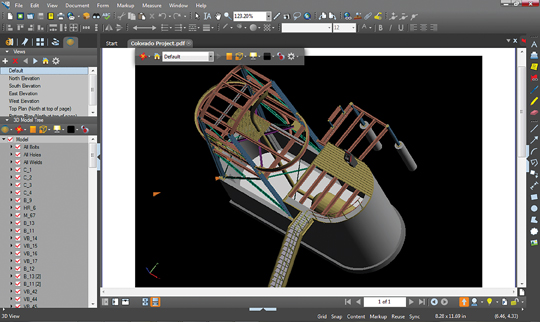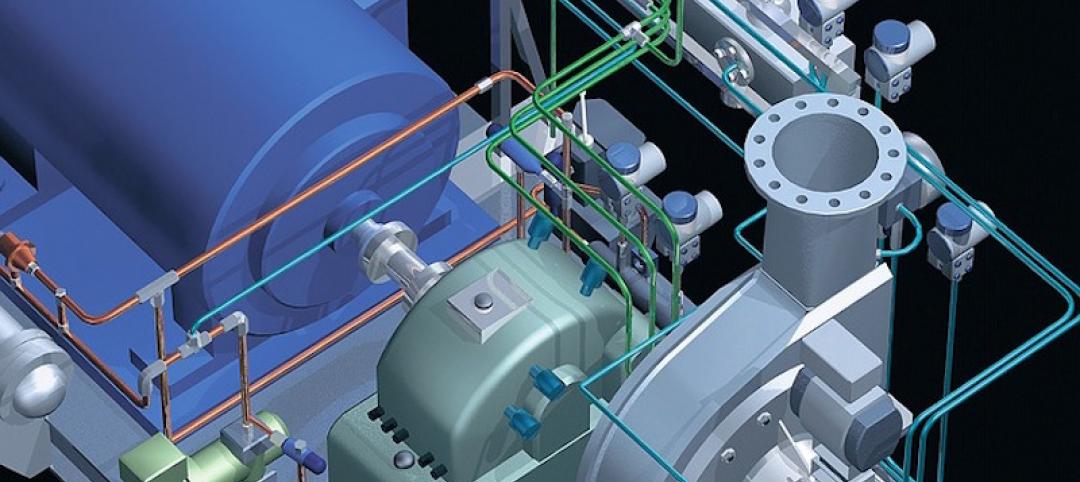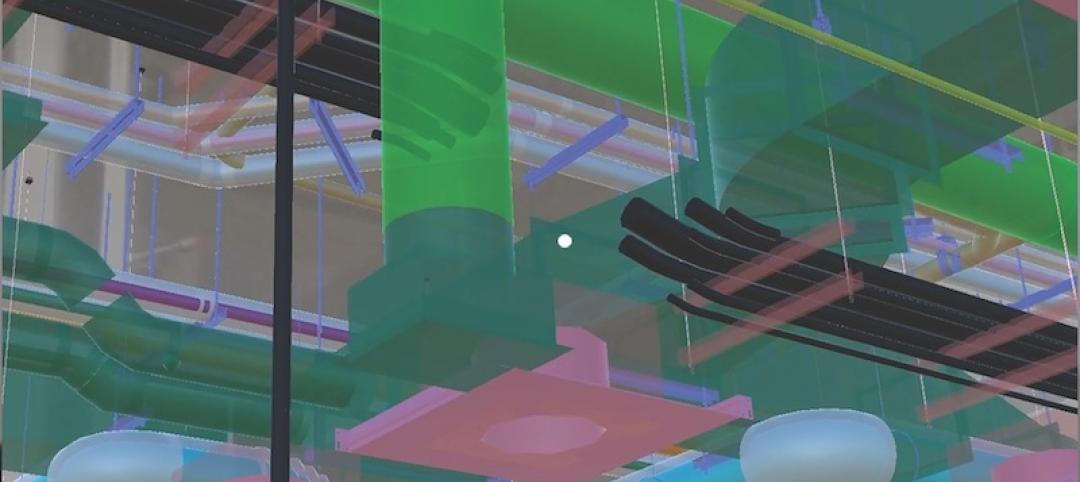The venerable portable document format (created in 1993 by Adobe Systems), an open standard since 2008, has evolved well beyond the simple document format it was created to be.
Today’s PDFs encapsulate a complete description of a fixed-layout 2D document that includes the text, fonts, images, and 2D vector graphics that comprise their root documents. Thanks to advances in 3D technology PDFs can now have 3D drawings embedded within them. They can even support Flash animations.
However, the question must be asked: How do these advances benefit AEC firms? AEC users have long relied on PDFs for large sheet sets and documents necessary to create their projects. As AEC firms augment their workflows from 2D to 3D, the PDF is not being abandoned. It is just being augmented for 3D.
“People are using PDF for real work,” said Don Jacob, VP of engineering at Bluebeam Software. “We’re seeing users employing it for punch lists, recording status during construction (completed or not completed), and operations matters.”
Bluebeam is taking its flagship PDF creation and editing software beyond 2D workflows with its new version, Bluebeam PDF Revu 9. I tried out the various Revu 9 programs for a month and a half in Bluebeam’s beta period.
The recently released software includes navigating-embedded 3D images and editing 3D models through a simple form tool. A premium edition, Bluebeam PDF Revu extreme, includes such features as OCR to make scanned PDFs text-searchable, forms creation, and scripting. Bluebeam has released new versions of its Standard and CAD versions of Revu 9, too, with batch processing of AutoCAD sheetsets and a new VisualSearch. Its search capabilities go far beyond simple text-only search and allow users to search for markings.
Revu 9 Standard: Now with a view
The big news with Revu 9 Standard is the viewing of 3D files. Bluebeam incorporated several ways to work with a 3D PDF. You can control it with your mouse or navigate your model through a toolbar; discrete views (for example, piping, structural) are also available in a dropdown menu. It’s a robust 3D viewer that lets you decide how you want to use it.
I found Revu 9 Standard ($179 per seat) to be a very stable 3D viewer. Built as a .NET application with managed memory code, the 3D viewer in Revu 9 is not susceptible to the crashing behavior that plagues some other 3D PDF viewers.
With .NET, memory is managed by Windows itself, which does a good job of following how much memory you’re using. This is preferable to letting the application write to memory sectors it shouldn’t be writing to, which can result in crashes. I experienced no crashes during my trial run. The application’s code is also written to allow GPU acceleration, so if you have a graphics card that supports it, the 3D viewer really sings when accelerated.
Using the multiple views available from the 3D panel, you can isolate the sections of a model you want to look at simply by highlighting them. If for some reason you want to come back to a certain section down the road, you can take a snapshot of that 3D model and paste it (in flattened form) into a 2D PDF for downstream use.
The second big advance in Revu 9’s standard edition is VisualSearch. Bluebeam PDF Revu has always had the ability to search a PDF for text. Now you can search visually. Click the VisualSearch radio button from the Search menu and it gives you a rectangle to select markings, symbols, or anything in the PDF that is not text. It will then show you all instances of that symbol in your plans. This PDF-searching tool is believed to be the first searchable symbol capability ever created for the format.
In addition to giving you a quick way to find symbols, Bluebeam also added the ability to apply annotations or hyperlinks to search results. This affords the opportunity to turn this information over to consultants and contractors further downstream.
Finally, Bluebeam has added the ability to measure for takeoffs with cutouts from its measurement tool. One of the concerns Bluebeam heard from AEC users was what if you’re measuring an area that’s cut out, such as a kitchen island, you couldn’t block off a place for it. The new measurement capability recognizes lossless vector information so it can give you accurate measurements. The new cutout tool lets you cut out sections and it will give you accurate square footage with that part of the still lossless data removed from the overall area. It’s a small but very useful improvement for architects and engineers.
One other enhancement to the mark-up tools: If your drawing has an area with two or more items that need to be called out, you can now put more than one leader on a call-out. Not earth-shattering, but worthwhile.
Revu 9 CAD: More control over output
The CAD edition ($239 per seat) incorporates all the features of the standard edition, along with one-click PDF creation and batch PDF creation from AutoCAD, Revit, and SolidWorks. Using Revu 9 CAD’s improved AutoCAD plug-in, for instance, you can add a whole folder of DWGs, or select individual files within a folder of DWGs and batch process them with one click. You can change the order of files in a folder with the batch tool or individually change the layout of how your final output file will look. You can also add stamps in your final PDF file from Revu 9 CAD’s stamp editor. Revu 9 CAD gives you a lot more control to determine what your final output PDFs look like. When you add files to a batch list, you can add an entire AutoCAD sheet set to the batch.
“Sheet sets are the standard method for handling physical plots,” according to Bluebeam VP Jacob. “Bringing them into the virtual plot, PDFs, reduces that redundant workflow.” Using the batch creation capability, you can bring in a sheet set where 90% of the work has been done, change the order, and click to get the order you want without altering the existing sheet set in AutoCAD.
The CAD edition was the one I tried out for most of my review period. I found the batch tools to be simple to use and useful for more than just CAD applications. In fact, I used it to create a batch of contracts from Microsoft Word files I wanted to convert to PDF; the output worked just as fine as it did for AutoCAD DWGs.
Revu 9 eXtreme: No middle ground
Too high or too low, there’s no in-between for Revu 9 eXtreme ($299 per seat). Packing more computing wallop than a Gary Cherone vocal, eXtreme has all the features of the CAD and Standard editions and adds optical character recognition (OCR) PDF form creation for procedures such as RFIs. The eXtreme edition also adds a scripting feature for power users who want to write their own PDF editing code scripts.
The problem with many PDFs on construction sites is that at some point someone scanned them from a physical document set. That makes the file a flat image converted to a PDF, and now it’s not searchable—just a dumb 2D image with lots of words and pictures that aren’t readily accessible. With OCR the text of any PDF becomes searchable. Go to the document menu and click on OCR, type what you want to search for, and the OCR process will run over the entire image, recovering the specific data you need even if it’s been flattened.
Using Revu 9 eXtreme to create forms, you can draw in text boxes and line up form fields in the forms tool to give your document a more professional-looking feel. You can also edit existing PDF forms; for example, you can turn check boxes into radio buttons or style them any way you want.
Another good tool for forms—a feature that firms which use PDFs for punchlists requested from Bluebeam—is the ability to apply custom statuses to any mark-up. You can add text to a component (such as “accepted” or “not accepted”) for mark-ups that have been noted to be problem areas. This nice, simple feature is available in all versions of Revu 9.
With the right design software, Revu 9 is capable of delivering a potent 3D workflow to design firms and construction companies preparing to make the switch from 2D to 3D.
Jeff (“BIMBoy”) Yoders blogs on BIM, CAD, and IT issues of importance to AEC professionals and firms at www.BDCnetwork.com.
Related Stories
BIM and Information Technology | Apr 5, 2018
Tech Report 5.0: Why wait for 3D renderings?
With emerging real-time rendering tools, project teams can design and render on the fly, for enhanced collaboration and resource savings. But the software comes with a catch.
Building Technology | Mar 1, 2018
Small construction businesses will continue to lag other sectors in tech spending this year
A survey of 800 companies found tepid interest overall in investing in “big data.”
BD+C University Course | Jan 2, 2018
The art and science of rendering: Visualization that sells architecture [AIA course]
3D artist Ramy Hanna offers guidelines and tricks-of-the-trade to ensure that project artwork is a stunning depiction of the unbuilt space.
Giants 400 | Dec 14, 2017
Top 85 BIM construction firms
Turner Construction Co., Gilbane Building Co., and The Whiting-Turner Contracting Co. top BD+C’s ranking of the nation’s largest BIM contractors and CM firms, as reported in the 2017 Giants 300 Report.
Giants 400 | Dec 14, 2017
Top 150 BIM design firms
Jacobs, Gensler, and WSP top BD+C’s ranking of the nation’s largest BIM design firms, as reported in the 2017 Giants 300 Report.
BIM and Information Technology | Dec 12, 2017
Reflecting on the future of work
'I believe in the potential for new technology to positively impact the quality of the built environment with immense speed and great efficiency,' writes Proving Ground's Nathan Miller.
Sponsored | BIM and Information Technology | Nov 30, 2017
A million small connections: Designing the new NY bridge
New York’s Tappan Zee Bridge first opened to traffic in 1955.
Sponsored | BIM and Information Technology | Nov 8, 2017
3 ways to protect your firm from cyber threats
While AEC firms may not have the vast quantity of financial information that certain other types of businesses do, the confidential and sensitive information your firm has can be just as damaging to your clients if it gets into the wrong hands.
Augmented Reality | Nov 6, 2017
Three VR + AR innovations to watch
From heat mapping to VR-based meetings, check out this trio of virtual and augmented reality applications for AEC teams.

















